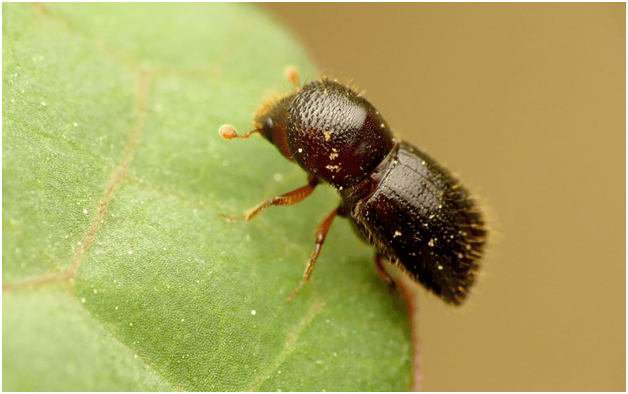
How To Beat The Ambrosia Beetles From Plants And Trees
One of the most interesting things about these beetles is their ability to destroy plants and trees in a matter of days. But before getting into how to beat them, it’s important to know how they got this way. This article will discuss how the ambrosia beetle got its name and what they do and what makes them so dangerous. You’ll also learn how to identify an infested tree, get rid of them, and prevent them from coming back with some easy tips that anyone can follow.
Table of Contents
What Are Ambrosia Beetles?
According to the Forestry Images website, ambrosia beetles are found across the United States and are considered a type of bark beetle. There are about 1,000 different species of this insect found in every state. They feed on the sap inside trees and plant stems and usually give off a strong odor.
These insects get their name because instead of larval stages developing in wood like other beetles, their larvae develop in a gallon on the outside of the tree. This gall is where the beetles lay their eggs and live. Inside these galls, you can find a fungus known as ambrosia, which is what gives this beetle its name. The larvae feed off of this fungus for about 30 days before maturing into adults, who then mate and look for new trees to go after.
Introduction
Knowing how to protect plants and trees from being attacked by bugs is important. This blog post gives a general overview of the types of bugs that attack plants, ways to prevent them, and natural methods for repelling them.
What are bugs?
There are many different insects, arachnids, and mites that feed on plants and trees. Insects include slugs, caterpillars, beetles, gnats, flies, and aphids. Arachnids have spiders, scorpions, and ticks. Mites include mites that live in the soil and spider mites that live on leaves. Some insects fly while others crawl or have no legs at all. Some of these bugs are larger than a penny, and others are the size of a pinhead.
Define the difference between an insect and a bug?
A bug is a type of insect with forewings that are leathery or hardened at the tips, like grasshoppers and cockroaches. An insect is an invertebrate animal with segmented body parts, including three distinct parts: head, thorax, and abdomen. It also has six legs, although some insects have four or eight legs. In general, insects are much smaller than bugs.
Common types of common insects include aphids and grasshoppers, two species that feed on plants. Aphids come from the same family as ants (Hymenoptera), but they do not bite or sting as ants do. Aphids drink plant sap and make lumps or colorful patches on the leaves of vegetables and fruit plants. Some aphids turn into winged adults that can fly to other plants when the weather turns warm.
How and when do Ambrosia Beetles appear?
Ambrosia Beetles are a type of beetle that feeds on plants and trees. Orange markings can distinguish them on their backs. They typically start attacking plants in August, but they can show up as early as July. They are found in the eastern United States, near areas with sandy soil and deciduous trees. The beatles will attack decaying logs in a forest, as well.
The ambrosia beetle is common in the eastern U.S., but it can be found throughout North America, from Canada to Mexico. It feeds on trees (particularly oaks), and they are most active in the fall when trees begin to lose their leaves. The insects lay their eggs under the bark, where the larvae chew tunnels into the wood and feed on fungus and nutrients found there. They spend the winter tunneling beneath dead wood and emerge in the spring to begin tunneling into live trees. They provide for about two years before emerging as adult beetles.
The ambrosia beetle is a small, dark-colored insect–usually reddish-brown to black. It has short antennae and a short, rounded abdomen. The beetle is generally less than 1/2 inch (1 centimeter) long and can’t fly or sting like other insects. This makes it relatively harmless unless you happen to be a tree. The ambrosia beetle is attracted to trees that are already weakened (such as those under stress due to too much or too little water, disease, or insects). The beetles lay eggs under the bark until they have burrowed into a tree’s vascular system and created tunnels.
The larvae then feed on the inner cortex of the tree, causing it to die. This is known as “ambrosia” because European naturalists first used the term to describe the food of the gods. Studies show that an infested tree dies in about 10-14 months. The beetles are typically carried to a tree by wind or flying in from a nearby source, such as another healthy tree. The beetles can fly only at night, and their flight range is less than half a mile (about 1 km). Once they land on a tree, the beetles burrow into the wood
under the bark and continue laying eggs until they have completely drained the life out of their host. The eggs hatch in two weeks, and the adult beetles begin laying eggs within four to five days of hatching. Each beetle lays an average of 200 eggs, allowing the infestation to spread rapidly. A few beetles can quickly turn into thousands and devastate a large area of forest land. The insect damage is easy to spot during the summer months because large patches of bark will have been stripped from the wood.
What plants and trees are they attracted to?
These beetles can be attracted to any plant, tree, or flower. It is best to plant various plants and trees in your garden to distract the beetle away from your favorite plants. You can also try using barriers such as stakes, wire mesh, or netting.
What do they eat?
They feed on the leaves of many plants and trees, but they will not cause any structural damage to the plant or tree. If you aren’t going to use herbicides, it is best to allow them to feed on your plants without spraying them with pesticides. The beetles can be dangerous to your family and pets because they secrete a toxin in their saliva which can cause toxic shock syndrome (TSS) if it gets into your eyes or any other body part.
Know about professional Ambrosia Beetle Treatment
This is an insect that many homeowners are unfamiliar with. It eats away the sapwood of a tree and eventually kills it by making circular holes in the bark. The best method to control Ambrosia Beetle is to have your trees inspected regularly and then treat them with chemicals if necessary. You can also make your spray to protect from the beetle if you have a large infestation.
Conclusion
While the beetle has a few natural predators, it is still encouraged to remove any beetles you see from the tree. This can be done by spraying the tree with water, an insecticide, or boiling water near the tree’s base. Covering nearby trees in sticky hot pepper sauce will also act as a deterrent. Another method to kill the beetles is to place sticky bands around tree trunks.





No Comment